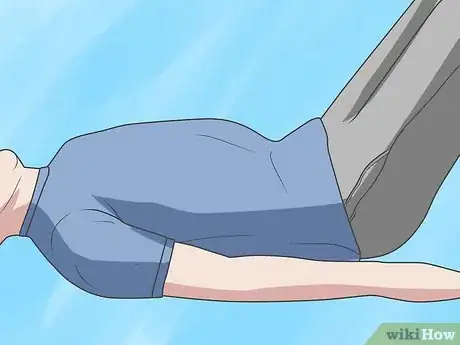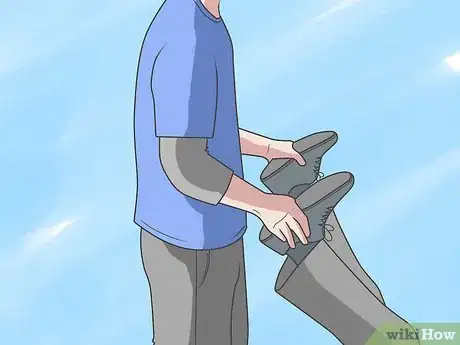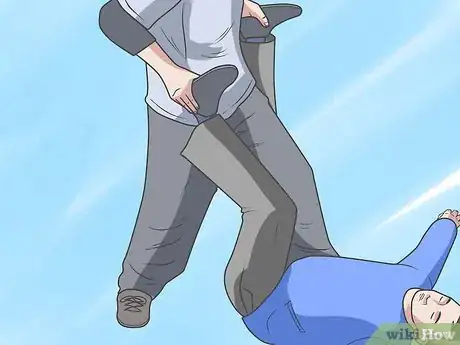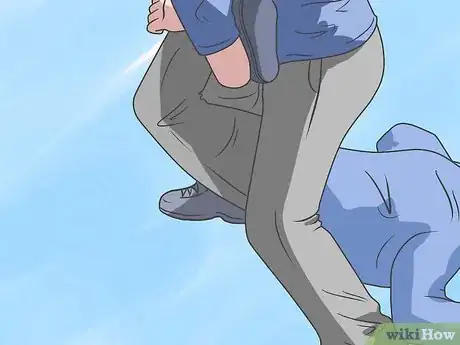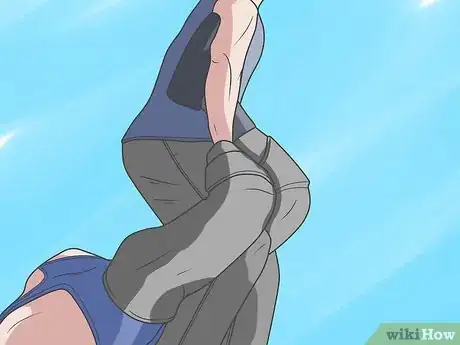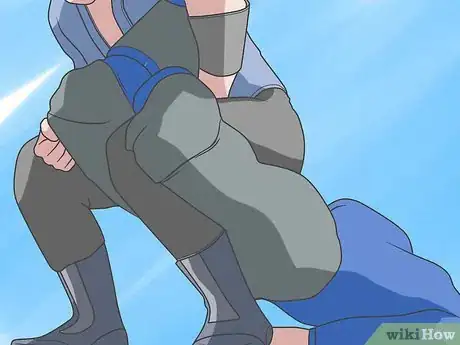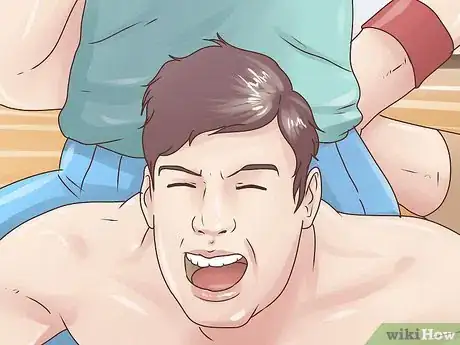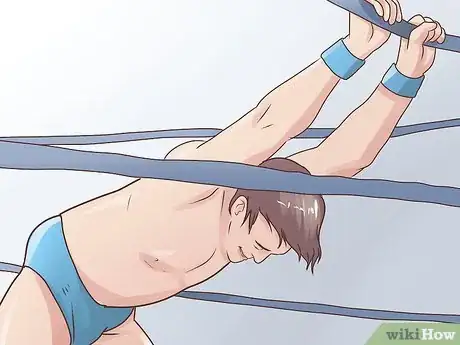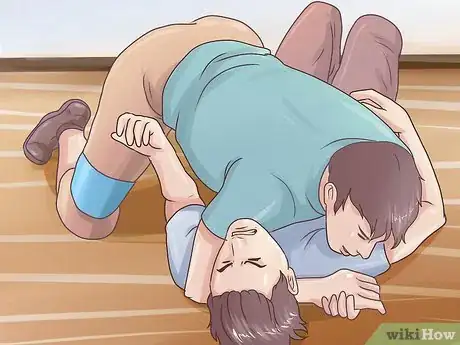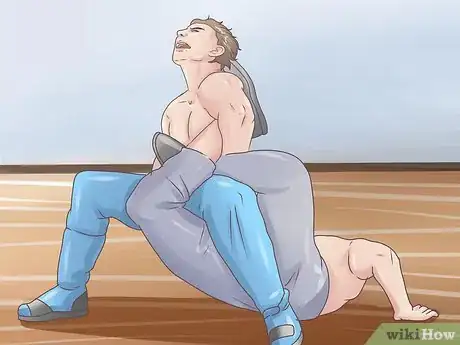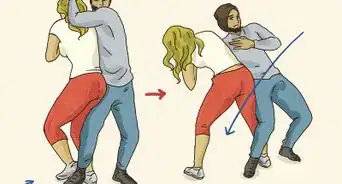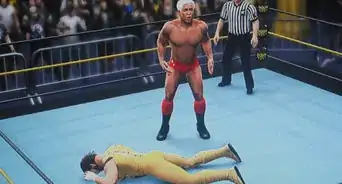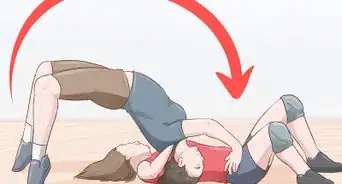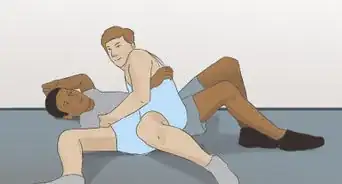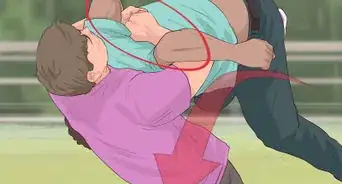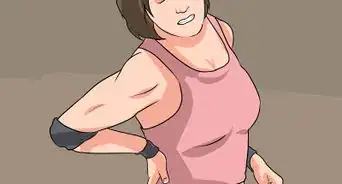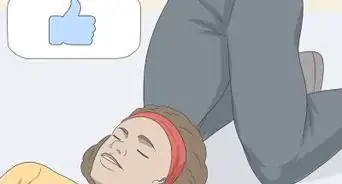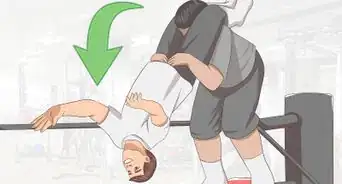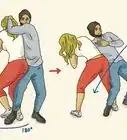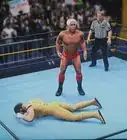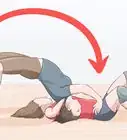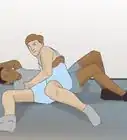wikiHow is a “wiki,” similar to Wikipedia, which means that many of our articles are co-written by multiple authors. To create this article, 15 people, some anonymous, worked to edit and improve it over time.
There are 10 references cited in this article, which can be found at the bottom of the page.
wikiHow marks an article as reader-approved once it receives enough positive feedback. In this case, 100% of readers who voted found the article helpful, earning it our reader-approved status.
This article has been viewed 64,094 times.
Learn more...
The revolutionary Japanese wrestler Riki Choshu invented a hybrid of the Boston Crab and the figure-four leg lock, which he called sasori-gatame, or "scorpion hold." Upon being adopted by Bret "The Hitman" Hart, the finishing submission hold became known as the sharpshooter, and is one of the most common and popular finishing holds in all of professional wrestling. The move is most identified with the Hitman, but lots of wrestlers have used it to great effect, including Sting, Shawn Michaels, Edge, and many others. It's a popular and simple move to perform, with the help of a willing participant. See Step 1 for more information.
Steps
Giving the Sharpshooter
-
1Place your opponent on their back in the center of the ring. To do the move correctly, you have to start by positioning your opponent so that they'll be far from the ropes to make the submission hold more believable. In general, the move is applied in the center of the ring so the opponent may not grab the ropes to break the hold. It's common to drag or otherwise place your opponent in the center for this reason.
- Pro wrestling moves are intricately choreographed maneuvers that need to be performed in a wrestling ring by two wrestlers who are communicating and working together. The sharpshooter is a move that looks devastating when performed correctly, but should cause absolutely no discomfort. Done incorrectly, you risk causing serious back injury.
-
2Lift your opponent's legs by gripping the arches of the feet. Take each foot in your hand and hold them about waist-level, forming a "V" with your opponent's legs.[1]Advertisement
-
3Step through with your dominant leg. If you're right-legged, step through the V of your opponent's legs and put your right foot on the mat next to his abdomen. Continue holding on to his feet.[2]
- You can do the move to either side by stepping through with either leg. Bret Hart always stepped through with his left leg, so technically, doing the sharpshooter means you should go to your left. However, the move is the same no matter which side you roll toward; the only difference involves the order in which you cross the opponent's legs, discussed in the next step.
-
4Cross your opponent's legs around your leg, starting with the near the leg. If you stepped to the right, cross the opponent's leg to your right (his left leg) over your thigh, then cross the other leg (his right leg) over it. Tuck the right ankle in your armpit, as you could for a front face lock, gripping it firmly.[3]
- Always start with the leg on the side toward which you stepped. If you step through with your left leg, cross your opponent's right leg first.
-
5Pivot and roll your opponent over by stepping across. If you started the move with your right leg, turn and step over your opponent's body, rolling them over in the process.[4]
- This should be a cooperative move: as you support your opponent's legs, he should flail his arms as if trying to resist, but should be shifting weight to roll over comfortably. This would be very difficult to do if your opponent dead-weighted, or resisted.
-
6Squat and support your own weight. Lean back into a squatting position while still holding onto both of their legs. Support your opponent's knee with your hand. You should squat just above your opponent's buttocks. Wrestlers will often rehearse such submission holds in the mirror while at the gym, to get a sense of how it should look.
- Don't pull back on your opponent's legs, but do pretend to pull back by straining your face and throwing your head back. The believability of the move depends on your making it look like you're pulling hard, but not.
- Under no circumstances should you sit with all your weight on your opponent's buttocks or back. This is an absolutely essential aspect of the move. While it looks like Bret Hart is sitting and cinching the move in, he's really doing a deep squat, supporting his own weight. It takes a lot of core and lower-body strength to support the weight of your opponent's legs and your own weight while squatting.
Receiving the Sharpshooter
-
1Help roll over. Don't just lay there like a sandbag. As the receiver of the sharpshooter, help to hold your legs up as much as possible and make it easier by shifting your weight up on your elbow and shoulder as you're being rolled.
- Depending on the story being told, it might be important to also give the appearance of struggling. Wave your free arm around and put a pained look of fear on your face. It'll look much better.
-
2Sell it. Once you've been rolled over, you've got to start acting. Scream and holler like it's painful, like you're having your legs pulled out of their sockets. Lots of wrestlers will grab their heads, bang on the mat, and start crawling for the ropes. If you just lay there, the move doesn't look good. In a certain way, it's mostly on you to make or break the move.[5]
- If the match calls for you to tap out–to give up–don't do it right away. Give off the impression like you're trying to hold out, you're trying to get out of it, and you don't want to give the match up. Then tap on your opponent's leg three times, reluctantly, signaling your withdrawal.
- Check out "Stone Cold" Steve Austin's sell of the sharpshooter at Wrestlemania 13 for inspiration. It's one of the iconic images of wrestling.
-
3Work on the common reverses and escapes. Just because you're wrapped up in a submission hold doesn't mean the only option is for you to tap out. There are less clear-cut reversals than in some other submission holds, but there are a few you can work out with your opponent, depending on whether or not the story calls for it.[6]
- Head for the ropes. The best way to break the sharpshooter is to grab hold of one of the ring ropes, which will give your opponent until the count of five to break the hold, or he will be disqualified. If you're in the center of the ring, get up on your elbows and start crawling, dragging your opponent with you. Intestinal fortitude to the max.
- Straighten your legs. Work with your opponent to power out of the sharpshooter by straightening your legs and pushing his torso toward the ground. If you work together, you could even shift into a roll-over pinning combination.
- Grab his ankle and flip into your own sharpshooter. If you can reach back and get your opponent off his feet, you'll release the weight and be able to stand up. Now, he'll be in position for the sharpshooter, or another Boston-Crab-type submission hold.
Performing Variations
-
1Try the Scorpion Death Lock. Wrestler Sting used the same basic hold as a finishing maneuver, with subtle differences. The Scorpion Death Lock always rolls to the right, for example, and typically Sting will make a big deal out of rolling over the opponent slowly, whereas Bret Hart cinches it in quickly. While Sting rolls it over, he points with his other hand straight up at the sky and yells out to the crowd, cheering wildly, before squatting.[7]
- According to wrestling lore, Bret Hart actually learned the move when a backstage employee suggested that he try out the wrestler Sting's finishing move as a submission hold, making the Scorpion Death Lock the original iteration of the hold.[8]
-
2Try the inverted sharpshooter or "Edgecator." One of the patented moves of the "Rated R Superstar" Edge, the Educator was basically a half-completed sharpshooter. To do the move, wrap up your opponent's legs as normal, and start turning over, but stop halfway. Instead of throwing your leg over, drop down on one knee, so your opponent is on his shoulder, giving the appearance of being bent sideways.[9]
- Have your opponent support his weight on his shoulder, essentially doing a side-bridge. It takes abdominal muscles of steel but looks great.
-
3Try the double-cross sharpshooter. In pro wrestling, the sharpshooter has become synonymous with controversy surrounding the 1997 Survivor Series match commonly known as the "Montreal Screwjob," in which Bret Hart–unbeknownst to him–lost after being put in his own finishing move. Because of this, the sharpshooter is the go-to move if something shady is going on in the match. Using the sharpshooter can be a tip of the hat to that still-controversial finish.[10]
Community Q&A
-
QuestionWhich move is best for breaking someone's arm or hand?
 Community AnswerKimura Lock for submission and Strong Arm Chop for non-submission, in my opinion.
Community AnswerKimura Lock for submission and Strong Arm Chop for non-submission, in my opinion. -
QuestionWhat are the best strength exercises for MMA fighting?
 Community AnswerPush-ups and pull-ups are the best arm strength exercises. You can also strength-train with weights or gym equipment.
Community AnswerPush-ups and pull-ups are the best arm strength exercises. You can also strength-train with weights or gym equipment. -
QuestionIs the sharpshooter more effective than the Boston crab?
 Community AnswerIt depends. An elevated Boston crab can't be too much more effective than the scorpion deathlock. If it does damage, it's enough to withstand long enough to reach the ropes or to reverse it. A Sharpshooter, on the other hand, is quite complicated.
Community AnswerIt depends. An elevated Boston crab can't be too much more effective than the scorpion deathlock. If it does damage, it's enough to withstand long enough to reach the ropes or to reverse it. A Sharpshooter, on the other hand, is quite complicated.
Warnings
- If you perform a pro wrestling maneuver like the sharpshooter in amateur wrestling at any level, you'll be disqualified, and probably kicked off your team.⧼thumbs_response⧽
- Under no circumstances should you perform the sharpshooter on an unwilling participant, sit on his back, or pull on his legs. Pro wrestling moves are performance, like dance.⧼thumbs_response⧽
References
- ↑ https://youtu.be/9xVzBL2ev84?t=75
- ↑ https://youtu.be/9xVzBL2ev84?t=90
- ↑ https://youtu.be/9xVzBL2ev84?t=96
- ↑ https://youtu.be/9xVzBL2ev84?t=110
- ↑ https://www.youtube.com/watch?v=Ku2HtEMkaG4
- ↑ https://prowrestling.fandom.com/wiki/Sharpshooter#Reversals
- ↑ https://www.youtube.com/watch?v=7LXr-guma6g
- ↑ http://prowrestling.wikia.com/wiki/Sharpshooter
- ↑ http://www.accelerator3359.com/Wrestling/moves/edge.html
About This Article
Before you do the sharpshooter, keep in mind that the move shouldn't cause you or your partner any discomfort and that doing the move incorrectly can cause serious back injury. To get started, place your opponent on their back. Then, grab their feet and lift their legs, stepping through their legs with your dominant foot. Next, cross your opponent's legs over your leg so one of their ankles is tucked in your armpit. Once their legs are secure, turn and step over their body so they roll over. Finally, squat down, making sure you're supporting your own weight and not sitting on your opponent. To learn how to receive the sharpshooter, scroll down!
